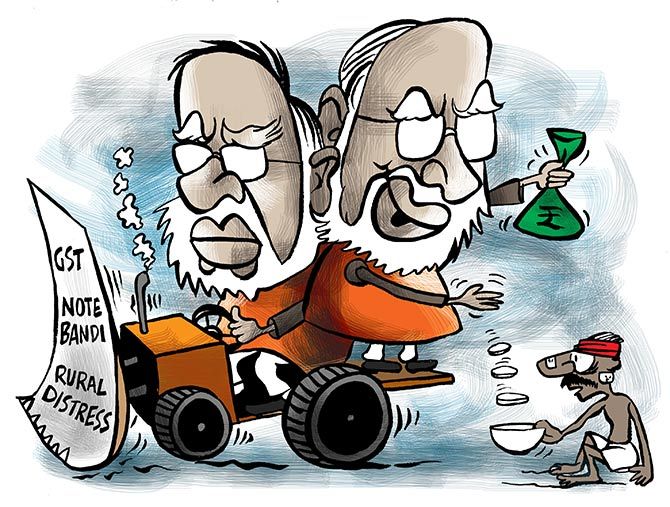'Should you give a man fish, or teach him how to fish?'
'Lurking hidden in the new bout of welfarism seems to be an admission that the State can't deliver for the poor anything other than cash,' notes T N Ninan.
Illustration: Uttam Ghosh/Rediff.com

In 2014, Arun Jaitley mentioned the 'neo-middle class' in the first paragraph of his Budget speech, and at least twice more before he had finished.
In contrast, the high point of Piyush Goyal's Budget speech was an ambitious handout programme for 120 million farming families.
From focusing on the 'aspirational', the government has gone 'aam aadmi' with a vengeance.
And yet, during the intervening five years, per capita income went up by about a third -- more than in any other country.
It is inevitable that the benefits of growth were distributed unevenly, but poverty levels halved in the decade to 2015-2016, according to a recent UN report that used the Multidimensional Poverty Index.
Some 270 million people (nearly a quarter of the population) moved out of poverty during this period.
Meanwhile, half the country now owns smart phones and Internet usage per smart phone has shot up from miniscule to among the highest in the world.
Almost as impressive, some 90 million scooters and motorcycles were bought in these last five years, and 40 million in the previous three years, making for a total of 130 million since 2011, when according to the Census one in five families already owned a powered two-wheeler.
Today the figure must be one in two families.
Further up the ladder, two-thirds of a million people flew every day last year, about 25 times the number that flew before aviation was opened up to private airlines.
If we are talking 'aspiration', surely something has been achieved.
So what explains the shift back from neo-middle class to aam aadmi, with the flavor of the season being loan write-offs, tax rebates and cash handouts?
It sounds very much like being back in 1971 with its battle-cry of 'garibi hatao' -- though per capita income today is seven times what it was then.
There is a difference, of course.
The first Mrs Gandhi's programme focused on hitting the rich with killer taxes and expanding the reach of the State, while the second Mrs Gandhi had the poor as the focus of her welfarism.
Narendra Damodardas Modi was right in describing the rural employment guarantee programme as a symbol of long-term Congress failure, but he has just given it a record outlay.
And under the right-to-food programme, grain is still being distributed at nearly the price that delivered electoral victory to N T Rama Rao in 1984 -- as though the nominal incomes of the poor have stood still over 35 years.
Not so; today's family can buy a month's requirement of grain with a single day's wages.
Yet, the political class has unanimously settled on more welfarism as the need of the hour.
Duality is one explanation, specifically that the country has not been able to create enough non-farm (therefore better-paying) jobs.
Disruption would be the other explanation, caused first by demonetisation and second by the goods and services tax, added to which there is distress on farms because producer prices have fallen.
Mr Modi would not admit to the second, but he also disputes the first, as he spelt out at length in his speech in the Lok Sabha, and you have to accept that there was logic in his argument.
But you could turn his other proposition on its head, and argue that the very success of the Mudra loan refinance programme (wherein job-seekers try to become job-creators) suggests disruption.
In any case, the government's actions suggest that it buys the entire narrative of duality, disruption and farm distress.
Perhaps it is nothing more than pre-emptive precaution in an election year, but one can glean motives from action taken.
A welfare State makes sense if it means the State providing education and health care for all.
Alternatively, handouts are affordable in a lower-middle income economy if you divert money from the less deserving, or if the promised benefits are not open-ended so that you don't get a runaway bill.
Without any of these, the old question begs an answer: Should you give a man fish, or teach him how to fish?
Lurking hidden in the new bout of welfarism seems to be an admission that the State can't deliver for the poor anything other than cash.











